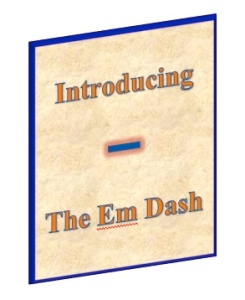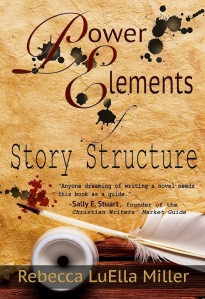 Because self-publishing has grown in ease and popularity, more and more writers are producing their own work for public consumption. Hence, I see the need for more instruction in the use of grammar and capitalization and punctuation, particularly marks like the em dash that may not be well known.
Because self-publishing has grown in ease and popularity, more and more writers are producing their own work for public consumption. Hence, I see the need for more instruction in the use of grammar and capitalization and punctuation, particularly marks like the em dash that may not be well known.
This post, with some minor editorial changes, first appeared here in April 2010. It’s about time I dusted it off, so we can take another look at em dashes. But be prepared: it comes with a writing exercise at the end, for those who wish to undertake the practice.
And now, The Em Dash:
I’ve been accused (gently) of overusing em dashes, commonly referred to without the qualifying “em.” These punctuation marks [—] differ in length and use from their lesser known, and shorter, cousins, the en dashes [–].
The thing about em dashes—they are incredibly versatile. They can do some of the jobs that commas do or ones parentheses do or even those that colons do. Maybe em dashes are the lazy writer’s answer to punctuation dilemmas: when in doubt, use em dashes. 😉 Well, it works for me!
Like anything else in writing (and in much of life), however, too much of a good thing becomes not such a good thing. In other words, em dashes in every other sentence may become distracting.
With that caution in mind, let’s look at specific uses of em dashes. First, they separate information that amplifies or explains from the rest of the sentence. Commas, parentheses, or a colon can do this too. Here are a few examples.
Example 1:
- The king—unable to sleep—called for the steward to read the scrolls detailing the affairs of state.
Or
-
The king (unable to sleep) called for the steward to read the scrolls detailing the affairs of state.
Or
- The king, unable to sleep, called for the steward to read the scrolls detailing the affairs of state.
Example 2:
- The basketball coach mapped out his plan of attack—a plan he hoped would surprise the opponent.
Or
- The basketball coach mapped out his plan of attack: a plan he hoped would surprise the opponent.
A second use of the em dash is to separate a subject (or a series of subjects) from a pronoun that introduces the main clause.
-
Lewis and Tolkien—they are the founding fathers of Christian fantasy.
As noted in an earlier post, “The Ellipsis or the Em Dash,” there’s a third common use—to indicate a sudden break in thought or speech.
- Clenching her fist, Barbara stomped after him. “No matter what you—”
Before she could finish her threat, Jeff slammed the door.
One more important point: no sentence should contain more than two em dashes. If further amplification is required, then commas or parentheses should be used.
But what about the en dash, that shorter little mark so similar to a hyphen? The Chicago Manual of Style says its principle use is to connect numbers (and occasionally words). For example, if you give a span of time, say, between 1999—2004, the proper mark between the numbers is the en dash.
So here’s an exercise if you choose to do it: First, look back at this post and see how many em dashes I used, apart from the examples, then rewrite those sentences using either commas, parentheses, or a colon. Second, identify at least one sentence each in which I used parentheses or a colon and rewrite those using em dashes.
How do you think the change in punctuation affects the sentence?


![PowerElementsCharacterDevelopment[1000][1]](https://rebeccaluellamiller.files.wordpress.com/2015/05/powerelementscharacterdevelopment10001.jpg?w=205)






Thank you!